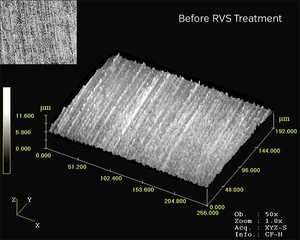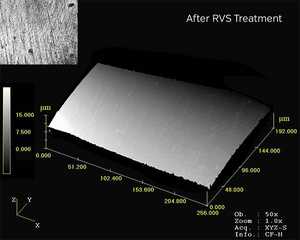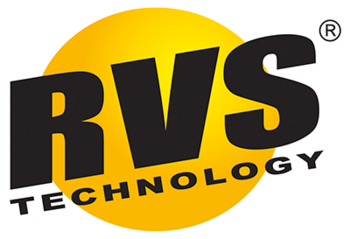Technology
RVS Technology® is a product that has been developed to have the capacity to form a Triboceramic surface structure on metal friction contact zones (metal-ceramic), while the mechanism is in its normal productive operation.
RVS has unique properties; it protects and prevents the surfaces and mechanisms against wear and tear. RVS is the only technology that has the ability to restore sliding surfaces, in good cases, up to their original shape and tolerances. The new surface structure takes place autoreactively, without disassembling the equipment being restored. In practice this means, without down times and loss of production.
The core of the technology is its ability to identify objects and points prone to wear and damage by “locating” the source of the thermal energy (heat) produced by the friction and its capacity to modify these friction surfaces. The process ceases automatically as the required result is obtained.


The thickness of the ceramic structure depends on the wear rate and the hardness on the surface pressure during the application. The higher the wear rate of the object to be treated, the more there are shocks and therefore energy for the formation of the Triboceramic surface structure.
The clearances in every surface that has friction in the mechanism, are optimised to a level hard to achieve by current application methods. All this takes place without downtimes, the need for expensive spare parts and costs of logistics, handling or remote processing. The result is a reliable, long term result for the treated mechanism.
- Prolongs life cycle of components (30–70 %)
- Reduces replacement demand for costly spare parts as wear process almost stops
- Reduces the number of expensive downtimes and maintenance hours/days
- Improves predictability of mechanism function
- Increase Engine Power
- Reduces energy & fuel consumption (5–10 %)
- Reduces emissions – Reduced environmental strain (10–30 %)
- Reduces vibration & noise level (10–50 %)
- Reduces need/Prolongs life cycle of lubricants (30–50 %)
- Possibility to use less expensive lubricants with fewer additives
- Fewer corrosion problems
- Survival of the mechanism in case of accidental loss of lubricant!

